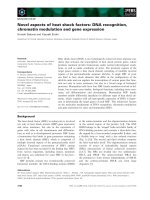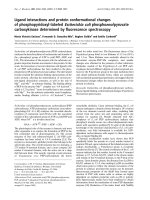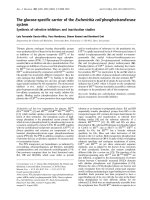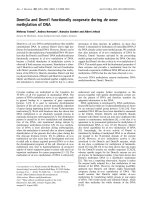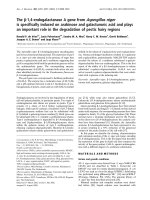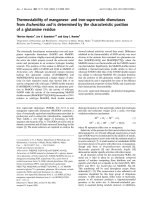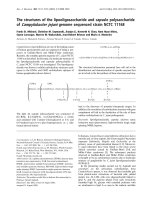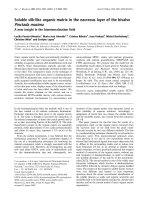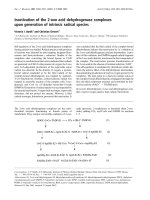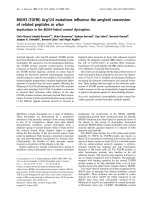Tài liệu Báo cáo Y học: Convulxin induces platelet shape change through myosin light chain kinase and Rho kinase ppt
Bạn đang xem bản rút gọn của tài liệu. Xem và tải ngay bản đầy đủ của tài liệu tại đây (183.68 KB, 7 trang )
Convulxin induces platelet shape change through myosin light chain
kinase and Rho kinase
Silvia Riondino, Pier P. Gazzaniga and Fabio M. Pulcinelli
Department of Experimental Medicine and Pathology, Universita
´
La Sapienza, Rome, Italy
Once platelets are activated, the first event to occur is a rapid
change in shape, associated with Ca
2+
/calmodulin-
dependent myosin light chain (MLC) phosphorylation and
with Rho kinase activation. The purpose of this study was to
investigate which is the biochemical pathway that leads to
platelet shape change in response to convulxin, a selective
GpVI activator, and to verify whether MLC phosphoryla-
tion is essential for this process. The inhibition of the Ca
2+
-
dependent pathway by means of the Ca
2+
chelator BAPTA,
the Ca
2+
/calmodulin inhibitor W-7 or the cAMP enhancing
drug iloprost reduced about 50% of platelet shape change in
response to convulxin. The treatment with either the Rho
kinase inhibitors Y27632 or HA 1077 had no effect on
platelet shape change induced by convulxin. When both
Ca
2+
/calmodulin-dependent and Rho kinase-dependent
pathways were concomitantly inhibited by the combined use
of Y27632 plus BAPTA, W-7 or iloprost, platelet shape
change was completely abolished. Our findings suggest that
convulxin-induced platelet shape change occurs via both
pathways, the Ca
2+
/calmodulin-dependent, which appears
to be more important, and the Rho kinase-dependent one.
The pattern of MLC phosphorylation was not modified by
Rho kinase inhibitors. Conversely, the inhibition of the
Ca
2+
-dependent pathway caused a strong reduction of
MLC phosphorylation in BAPTA-treated platelets, and a
total inhibition in W-7 or iloprost-treated platelets. Our
results demonstrate that following Rho kinase-dependent
pathway platelet shape change can occur without the
involvement of MLC phosphorylation.
Keywords: convulxin; cyclic AMP; myosin light chain kin-
ase; platelet shape change; Rho kinase.
One of the first events to follow platelet functional response
to various stimuli is the rearrangement of cytoskeletal
proteins, such as actin and myosin, with the consequent
change from the discoid to the spheroid shape and the
production of pseudopodia [1]. It has been demonstrated
that a crucial event in triggering shape change is myosin
light chain (MLC) phosphorylation [2]. The signal origin-
ating from agonist-induced activation can lead to MLC
phosphorylation through two distinct pathways. One is the
Ca
2+
/calmodulin-dependent pathway, subsequent to Ca
2+
mobilization and mediated by MLC kinase [3], and the
other is Ca
2+
-independent, subsequent to the small GTP-
binding protein RhoA activation, and mediated by Rho
kinase [4–6]. The Ca
2+
/calmodulin-dependent pathway
which leads to MLC phosphorylation depends upon the
stimulation of a G
q
-coupled receptor and phospholipase C
(PLC) activation. This datum has also been supported by
experiments on G
aq
-deficient mice platelets [7]. On the other
hand, the Ca
2+
-independent pathway follows the stimula-
tion of a G
12
/G
13
coupled receptor [4].
The second messenger cAMP also exerts an efficacious
action on cytoskeletal rearrangements, by inhibiting actin
assembly and focal adhesion in many cell types [8,9] through
the decreased phosphorylation of various proteins [10,11]
including MLC [12].
In a previous study of our group, it was found that it was
possible to by-pass the inhibitory effect of cAMP on the
multistep cascade of biochemical and morphological events
that result in platelet aggregation, provided a G
q
-coupled
receptor and a G
i
-coupled receptor were activated [12]. In
the same study it was demonstrated that the activation of
PLC was sufficient to elicit full aggregation, in spite of
elevated intracellular concentrations of cAMP, in the
presence of an activated G
i
protein.
The activation of a PLC isoform, PLC c2, might be
achieved using the snake venom toxin convulxin. Convulxin
activates platelets through the collagen receptor complex
glycoprotein VI (GpVI)/Fc receptor c-chain, leading to
tyrosine phosphorylation and activation of syk and PLCc2
[13,14]. Following activation of GpVI by convulxin, several
adapter molecules are tyrosine phosphorylated and/or
recruited into intracellular signalling complexes; many of
the adapter proteins associate with the transmembrane
adapter LAT [15].
Francischetti and his coworkers demonstrated that
cAMP did not inhibit the early onset of convulxin-induced
tyrosine-phosphorylation of PLCc2, which also occurs in
the presence of the aIIb/b3 antagonist, peptide RGDS, or
actin polymerization inhibitors, such as cytochalasin D [16].
The purpose of the present study was to investigate the
biochemical pathways followed by convulxin in inducing
Correspondence to P. Gazzaniga, Department of Experimental
Medicine and Pathology, Universita
´
La Sapienza, Viale Regina
Elena 324, 00161 Rome, Italy.
Fax: + 39 064452955, Tel.: + 39 064454820,
E-mail:
Abbreviations: A3P5P, adenosine 3¢-phosphate 5¢-phosphate;
BAPTA, 1,2-bis(2-aminophenoxy)ethane-N,N,N,N-tetraacetic acid;
CP/CPK, creatine phosphate/creatine kinase; HA, 1077
(1-(5-isoquinolinesulfonyl)homopiperazine); MLC, myosin light
chain; MLCK, myosin light chain kinase; PLC, phospholipase C;
W-7, N-(6-aminohexyl)-5-chloro-1-naphtalenesulfonamide.
(Received 3 January 2002, revised 8 October 2002,
accepted 11 October 2002)
Eur. J. Biochem. 269, 5878–5884 (2002) Ó FEBS 2002 doi:10.1046/j.1432-1033.2002.03305.x
platelet shape change. In particular, the roles of Rho kinase
and of MLC kinase have been studied by means of specific
inhibitors in order to asses whether the Rho/Rho kinase
pathway is an additional route in mediating platelet shape
change in response to convulxin, independently of the
Ca
2+
-dependent pathway.
MATERIALS AND METHODS
Platelet preparation
Blood samples were obtained from informed healthy
volunteers who denied having taken any drugs in the two
weeks before blood sampling and collected in citric acid/
citrate/dextrose-containing tubes [17].
Platelet rich plasma was obtained after centrifugation
(180 g for 15 min) and further centrifuged (800 g for
20 min) to concentrate the platelets (6 · 10
8
plateletsÆmL
)1
).
The concentrated platelets were incubated for 15 min at
37 °Cwith1m
M
aspirin (Sigma Chemicals Co., St. Louis,
MO, USA) then washed twice in Tyrode’s buffer (137 m
M
NaCl, 2.68 m
M
KCl, 0.42 m
M
NaH
2
PO
4
,1.7m
M
MgCl
2
)
containing 10 m
M
Hepes (pH 6.5) and resuspended in
Tyrode’s buffer containing 0.2% (w/v) albumin (bovine
serum fraction V-BSA), 0.1% (w/v) glucose and 10 m
M
Hepes (pH 7.35) (all from Sigma Chemicals).
To enhance cAMP levels, platelets were treated with
iloprost (3 l
M
for 2 min at 37 °C) (generous gift of
Italfarmaco S.p.a., Italy). This platelet preparation was
further incubated with the ADP scavenger system creatine
phosphate/creatine kinase (CP/CPK) (4 m
M
and
10 UÆmL
)1
, respectively, Sigma Chemicals) before the addi-
tion of the agonist. Samples were treated with N-(6-amino-
hexyl)-5-chloro-1-naphtalenesulfonamide (W-7) (90 l
M
)to
inhibit the Ca
2+
/calmodulin pathway [18,19] (Sigma Chem-
icals). HA 1077(1-(5-isoquinolinesulfonyl)homopiperazine)
(10 l
M
)[20,21](BioMolRes.Laboratory,Inc.,PA,USA)
and Y27632 (10–30 l
M
) (Calbiochem-Novabiochem San
Diego, CA, USA) were used as Rho-kinase inhibitors.
Platelet stimulation was achieved by means of convulxin
(5 ngÆmL
)1
) (Latoxan, Rosans, France), purified according
to Polgar et al. [13].
Platelet shape change
In vitro platelet shape change was evaluated in a four
sample PACKS-4 (Helena Laboratories, Beaumont, TX,
USA) aggregometer using siliconized glass cuvettes at 37 °C
under continuous stirring. Once the full function of the
platelet preparation was tested in response to convulxin
(5 ngÆmL
)1
), in order to prevent platelet aggregation and
allow shape change to occur, platelets were pretreated with
RGDS (120 lgÆmL
)1
) which inhibits fibrinogen binding to
the integrin a
IIb
b
3
. The magnitude of the shape change was
detected by measuring the maximum decrease in light
transmission and the slope value. The last parameter was
obtained from the tangent to the curve and was measured in
millimetres per minute.
Changes in intracellular calcium mobilization
The fluorescent changes in intracellular calcium mobiliza-
tion were studied in Fura-2 (Molecular Probes, Eugene,
OR, USA) loaded platelets (3 l
M
at 37 °C for 30 min) and
monitored in a Kontron SFM 25 spectrofluorimeter
thermostatically regulated at 37 °C. Excitation and emission
wavelengths were 340 n
M
and 510 n
M
, respectively. Intra-
cellular free calcium concentration was calibrated according
to Grynkiewicz [22].
Preparation of BAPTA-loaded platelets
The concentrated platelets were incubated for 30 min at
37 °Cwith1m
M
aspirin, 100 l
M
1,2-bis(2-aminophen-
oxy)ethane-N,N,N,N-tetraacetic acid acetoxymethyl ester
(BAPTA-AM) (Molecular Probes), then washed by centri-
fugation. The platelet preparation was further treated with
CP/CPK (4 m
M
and 10 UÆmL
)1
, respectively) before the
addition of the agonist. If the Dn
M
of Ca
2+
obtained in
response to agonist stimulation was higher than 10, the
platelet suspension was not used.
Myosin light chain phosphorylation
MLC phosphorylation was analysed according to Daniel
et al. [23]. Briefly, aspirinated platelets were resuspended in
Tyrode’s buffer at a concentration of 2 · 10
9
cellsÆmL
)1
.
Aliquots of 500 lL were stirred at 37 °C in an aggrego-
meter. After30 s from convulxin stimulation (5 ngÆmL
)1
)the
reaction was stopped by adding 6.6
M
HClO
4
; the resulting
precipitate was kept for 45 min in ice. The pellets were
centrifuged at 10 000 g for 2 min and washed twice with ice-
cold deionized water. The proteins were further centrifuged
at 10 000 g for 2 min and the resulting pellets were dissolved
in 50 lL of sample buffer containing 8
M
urea, 20 m
M
Tris,
(pH 8.6), 122 m
M
glycine, 5 m
M
dithiothreitol to which
0.1% (w/v) bromophenol blue dye was added. The suspen-
ded pellet was sonicated in a PBI Briansonic 220 sonication
bath for 30 min. Gel electrophoresis was performed in a
10% (w/v) polyacrylamide-urea minigel apparatus (Hoefer
Scientific Instruments, San Francisco, CA, UA). The
running buffer used in the top chamber was composed of
20 m
M
Tris and 122 m
M
glycine at pH 8.6 containing 4 m
M
urea. The electrophoresis was stopped 1 h after the blue
marker had migrated off the end of the gel. Gels were
stained in 0.25% (w/v) Coomassie Brilliant Blue (Sigma),
destained and dried in an SE 1200 Easy Breeze Air Gel
Dryer (Hoefer) apparatus. The gels were then scanned using
a Gel Doc 2000 (Bio-Rad Laboratories, Hercules, CA,
USA) scanner and the optical densities corresponding to the
phosphorylated form of MLC were analysed using the
program
NIH IMAGE
1.62 and reported as mean grey values.
The results were expressed as the percentage of maximal
MLC phosphorylation induced by convulxin.
To confirm the identity of the detected band, further
sample proteins were transferred to Immobilion-P (Milli-
pore) membranes and identified with anti-MLC mono-
clonal Ig (Sigma Chemicals), followed by horseradish
peroxidase-conjugated secondary antibody and visualized
with ECL chemiluminescence reaction reagent (Amersham)
and Kodak X-ray film (X-OMAT AR).
RESULTS
To investigate the correlation between the increase in
intracellular Ca
2+
concentration and shape change in
Ó FEBS 2002 Convulxin-induced platelet shape change (Eur. J. Biochem. 269) 5879
convulxin-induced platelet activation, we studied platelet
shape change and MLC phosphorylation in experimental
conditions in which either Ca
2+
/calmodulin or Rho-kinase
pathways were inhibited.
The increase in the cytosolic Ca
2+
concentration, which
occurs normally after convulxin (5 ngÆmL
)1
) stimulation
(743.6 ± 192.2 Dn
M
), was strongly inhibited in platelets
treated with the cAMP-enhancing drug iloprost (3 l
M
)
(Fig. 1).
Table 1 summarizes the variation in shape change
induced by 5 ngÆmL
)1
convulxin, indicating the magnitude
and slope of aspirinated platelets in the presence of Ca
2+
/
calmodulin or Rho-kinase inhibitors, that are also repre-
sentatively shown in Fig. 2. The results shown in Fig. 2A
demonstrate that when the two pathways were separately
inhibited by treating the platelets with either the calmodulin
inhibitor W-7 (90 l
M
) or with the Rho kinase inhibitors
HA 1077 (10 l
M
) or Y27632 (30 l
M
), we observed only a
slight reduction in the rate of shape change (more
pronounced when the Ca
2+
-dependent pathway was inhib-
ited) as compared to control, untreated, convulxin-stimula-
ted platelets. Then, in order to minimize the cytosolic
concentration of calcium, we treated our platelet prepar-
ation with 5,5¢-dimethyl BAPTA (Fig. 2B), and studied
both the magnitude and the slope of the shape change.
Under these conditions we found that both were slightly
decreased, with a delay in the initiation of the process. A
more pronounced reduction was observed in the presence of
high concentrations of iloprost (3 l
M
) (Fig. 2C). A similar
degree of reduction was observed after the simultaneous
treatment with calmodulin inhibitors and iloprost, suggest-
ing that these agents were acting on a common pathway.
However, when iloprost was added to 5,5¢-dimethyl
BAPTA-loaded platelets, both the extent and the rate of
shape change were significantly inhibited (Fig. 2C).
A complete inhibition was obtained when both pathways,
Ca
2+
-dependent and Rho-dependent, were simultaneously
blocked by adding the calmodulin inhibitor W-7 or iloprost
or when the increase in cytosolic Ca
2+
concentration was
minimized by BAPTA, to HA 1077- or Y27632-treated
platelets.
Interestingly, a complete inhibition of platelet shape
change was achieved by notably lowering the concentrations
of HA 1077 or Y-27632 when used in combination with
W-7 (Table 1).
To avoid any possible interference with platelet shape
change caused by released ADP on its receptor P2Y
1
,we
incubated our CP/CPK-treated platelet preparation with
Fig. 1. Changes in intracellular calcium concentration in 5 ngÆmL
)1
convulxin-stimulated aspirinated platelets. Stimulation in the (a)
absence and (b) presence of 3 l
M
iloprost. The figure is representative
of three experiments performed.
Table 1. Effects of different inhibitory treatments on platelet shape change in response to 5 ngÆmL
)1
convulxin stimulation.
Treatment Magnitude Slope
None 14.07 ± 3.34 6.74 ± 2.11
+ HA 1077 (10 l
M
) 13.36 ± 2.87 5.59 ± 2.81
+ Y-27632 (30 l
M
) 13.96 ± 2.31 6.09 ± 2.77
+ W-7 (90 l
M
) 5.87 ± 3.34* 3.38 ± 1.22**
+ W-7 (30 l
M
) + HA 1077 (5 l
M
) absent not measurable
+ W-7 (30 l
M
) + Y-27632 (10 l
M
) absent not measurable
BAPTA (100 l
M
) 6.75 ± 2.51* 3.21 ± 1.18**
+ HA 1077 (10 l
M
) absent not measurable
+ Y-27632 (30 l
M
) absent not measurable
+ W-7 (90 l
M
) 5.99 ± 2.31* 3.76 ± 2.17**
+ Iloprost (3 l
M
) 4.29 ± 0.76** 2.01 ± 1.14**
Iloprost (3 l
M
) 4.48 ± 0.96** 2.99 ± 1.25**
+ HA 1077 (10 l
M
) absent not measurable
+ Y-27632 (30 l
M
) absent not measurable
+ W-7 (90 l
M
) 4.24 ± 1.18** 2.83 ± 1.75**
*P < 0.05; **P < 0.01.
5880 S. Riondino et al.(Eur. J. Biochem. 269) Ó FEBS 2002
the selective P2Y
1
inhibitor adenosine 3¢-phosphate
5¢-phosphate (A3P5P) (100 l
M
for 1 min at 37 °C) and
obtained the same results as those observed after CP/CPK
treatment alone.
This result suggests that the ADP secreted is promptly
scavenged by CP/CPK and that the residual ADP is at too
low a concentration to activate the P2Y
1
-receptor coupled
pathway.
Because MLC phosphorylation has been suggested to be
involved in early processes during platelet activation [24] we
measured the appearance of a 20-kDa band, indicating
MLC phosphorylation consequent to the activation of the
two pathways, Ca
2+
-dependent and Ca
2+
-independent,
and determined the action exerted by the different inhibi-
tors. Rho kinase inhibition by HA 1077 or Y27632 did not
significantly modify the pattern of MLC phosphorylation
after convulxin stimulation (63.0 ± 10.9 for HA 1077 and
66.33 ± 12.6 for Y-27632 vs. 78.6 ± 11.4 mean grey
value), equal to 19.8% and 15% reduction, respectively
(Fig. 3A).
The identity of the 20 kDa band detected was confirmed
by immunoblot analysis by means of an anti-MLC mono-
clonal Ig (data not shown).
Inhibition of the increase in cytosolic Ca
2+
by BAPTA
(Fig. 3B) reduced by about 40% the maximum level of
MLC phosphorylation (45.7 ± 9.6 mean grey value vs.
78.6 ± 11.4) induced by convulxin. It is worth noting that,
since BAPTA treatment might delay the time course of
MLC phosphorylation [5], we performed experiments at 60,
120, 150 and 180 s, but we did not observe any further MLC
phosphorylation (data not shown). Inhibition of calmodulin
by W-7 (90 l
M
) completely abolished MLC phosphoryla-
tion (Fig. 3A), while a certain degree of platelet shape
change was still preserved although significantly reduced
(Table 1).
The increase in intracellular cAMP levels by iloprost
completely inhibited MLC phosphorylation (4.2 ± 0.7
mean grey value) (Fig. 3C).
When both the Ca
2+
-dependent and Ca
2+
-independent
pathways were inhibited by the combined treatment with
HA 1077 or Y27632 and W-7 or BAPTA, we did not
observe any phosphorylation of MLC.
DISCUSSION
The initial functional response of platelets to stimuli is
represented by shape change, during which phase platelets
are subject to cytoskeletal reorganization consequent to the
phosphorylation of several contractile proteins. It has
already been demonstrated that such a phenomenon can
occur both in the presence and in the absence of an increase
of cytosolic Ca
2+
concentration in response to thrombin,
ionomycin, the stable prostaglandin endoperoxide analogue
U44069 and the thrombin receptor activating peptide
[25–27]. Other authors [4] observed that the thromboxane
A2 synthetic analogue, U46619, was not able to induce a
detectable elevation of intracellular Ca
2+
concentration in
the absence of G
aq
and that Rho kinase inhibitor Y-27632
and C3 exoenzyme inhibited the U46619-induced MLC
phosphorylation in G
aq
-deficient mouse platelets. These
observations led them to conclude that a Rho/Rho kinase
pathway regulating MLC phosphorylation operated in
platelets and that Rho kinase mediates the Ca
2+
-independ-
ent pathway. The dichotomous regulation of MLC phos-
phorylation and shape change by Rho kinase and calcium in
human platelets was demonstrated by other studies carried
out with several agonists, different from convulxin [5,6,28].
Elevated cAMP and the consequent activation of protein
kinase A affects cell morphology, inducing the loss of actin
stress fibres and their detachment from the underlying
Fig. 2. Platelet shape change in response to
5ngÆmL
)1
convulxin. (A) Shape change in the
presence of the calmodulin inhibitor W-7
(90 l
M
) or Rho kinase inhibitors HA 1077
(10 l
M
) and Y-27632 (30 l
M
)inaspirinated,
RGDS-treated, control platelets. The
response to convulxin stimulation in the
presence of the cited inhibitors of platelets
loaded with 100 l
M
BAPTA for 30 min at
37 °C(B)ortreatedwith3l
M
iloprost for
2minat37°C (C). The figure is
representative of four experiments
performed.
Ó FEBS 2002 Convulxin-induced platelet shape change (Eur. J. Biochem. 269) 5881
substratum in many cell types [9,29]. Protein kinase A, once
activated, phosphorylates myosin light chain kinase
(MLCK), thus inhibiting its activity and causing a decrease
in MLC phosphorylation [8].
As regards the inhibition exerted by cAMP on the
biochemical pathway leading to platelet shape change
following convulxin activation, the results shown in this
paper demonstrate that it is possible to evoke platelet shape
change even in the presence of elevated intracellular
concentrations of cAMP. This observation leads us to
hypothesize that the inhibitory action of cAMP is not
exerted at the level of Rho kinase pathway.
The conclusion that shape change responses were not due
to ADP release arises from two observations. First, the
degranulation process was dramatically reduced in convul-
xin-stimulated platelets treated with iloprost. This showed a
reduction of about 86% of the intracellular ATP as
compared to convulxin-stimulated platelets untreated with
iloprost, as already demonstrated in a previous study from
our group [12]. Second, in all preparations platelets were
treated with the ADP scavenger system CP/CPK to ensure
that even traces of ADP released could not interfere with the
experiments.
Furthermore, experiments employing the inhibitor of the
ADP receptor P2Y
1
(the only receptor involved in platelet
shape change induced by ADP [28,30]), A3P5P, demon-
strated no additional inhibition as compared to CP/CPK
alone (data not shown).
Iloprost treatment strongly affected convulxin-induced
MLC phosphorylation, only partially acting on the Ca
2+
-
dependent pathway which, in fact, was inhibited as dem-
onstrated by fluorimetric studies on intracellular Ca
2+
mobilization. This result also demonstrates that in response
to convulxin Ca
2+
mobilization can be inhibited by
elevating the levels of intracellular cAMP, as shown in
studies using different agonists [31]. However, the inhibition
of Ca
2+
mobilization alone is not sufficient to cause a
complete inhibition of MLC phosphorylation, as demon-
strated by the experiments with BAPTA, which only
diminished MLC phosphorylation by about 50%. The
enhanced capability of cAMP of inhibiting MLC phos-
phorylation can be explained by the direct action of cAMP
on MLCK [8].
Antagonizing the Ca
2+
-dependent pathway at different
stages by means of the Ca
2+
/calmodulin inhibitor, W-7, or
with the cytosolic Ca
2+
chelator BAPTA, we observed a
good degree of platelet shape change in response to
convulxin. This indicates that the inhibition exerted by
these inhibitors on the Ca
2+
-dependent pathway did not
affect the Rho kinase-dependent one.
In fact, while the inhibition of Rho kinase by means of the
inhibitors HA 1077 or Y-27632 was without any effect on
platelet shape change and MLC phosphorylation induced
by convulxin, a complete inhibition of platelet shape change
was achieved only when both pathways were concomitantly
inhibited, combining HA 1077 or Y-27632 treatment with
iloprost, W-7 or BAPTA treatment. These results suggest
that both pathways are involved in platelet shape change
induced by convulxin and that, since Rho kinase inhibitors
are less powerful in interfering with such a process, the
Ca
2+
-dependent one is more effective.
The fact that BAPTA treatment reduced convulxin-
induced MLC phosphorylation, while the rate of inhibition
of platelet shape change was similar to that observed after
W-7 or iloprost treatment, might be explained by the
demonstration that a weak activation of MLC phosphory-
lation is not sufficient to elicit shape change [6].
Bauer and coworkers [5] suggested that the GpVI-
specific agonist, collagen-related peptide, causes shape
change by a mechanism that is entirely dependent on
calcium, since it is not affected by the Rho kinase
inhibitor Y-27632. Their conclusion delineated the exist-
ence of two distinct pathways of myosin phosphorylation
Fig. 3. Myosin light chain phosphorylation in response to aspirin-trea-
ted, convulxin stimulated (5 ng mL
)1
, for 30 s at 37 °C) platelets. (A)
Phosphorylation in the presence of calmodulin inhibitor W-7 (90 l
M
)
or Rho kinase inhibitors HA 1077 (10 l
M
) and Y-27632 (30 l
M
). The
effects of the same inhibitors on (B) BAPTA-treated (100 l
M
for
30 min at 37 °C) or (C) Iloprost-treated (3 l
M
for 2 min at 37 °C)
platelets. The quantitative comparison of the effects of the cited
inhibitors is reported. Results are shown as mean ± SEM of four
experiments. The level of MLC phosphorylation of resting platelets
was subtracted and the results expressed as percent of the maximal
MLC phosphorylation induced by convulxin alone (78.6 ± 11.4 mean
grey value) (A).
5882 S. Riondino et al.(Eur. J. Biochem. 269) Ó FEBS 2002
and platelet shape change, one mediated by Rho kinase
and the other by the Ca
2+
-dependent activation of MLC
kinase. These two pathways could be activated independ-
ently of each other, depending on the type and concen-
tration of the agonist used. The Rho kinase-dependent
pathway was stimulated by the activation of thrombin
and thromboxane receptors as opposed to the Ca
2+
-/
MLC kinase-dependent pathway that was stimulated by
ADP and collagen receptor activation. Like collagen,
convulxin has also been described as a GpVI agonist [13].
The different behaviour of this agonist that emerged in
our study might be explained by the fact that it is more
efficacious than collagen-related peptide [15].
Taken together our findings suggest that convulxin is able
to cause shape change by activating both pathways, the
Ca
2+
-dependent and Rho/Rho kinase-dependent. The
former appears to be more important, while the latter
seems to represent an additional route in mediating platelet
shape change and becomes preferentially involved in
response to stimuli that do not produce any increase in
cytosolic Ca
2+
concentration, or when the Ca
2+
/calmo-
dulin-dependent pathway is not operating (Fig. 4). More-
over, our results demonstrate that following Rho A/Rho
kinase activation, convulxin-induced platelet shape change
can occur without the involvement of MLC phosphoryla-
tion.
ACKNOWLEDGEMENTS
This work was partially supported by Grant 60% Ateneo 2000.
We thank Prof Luisa Lenti for her precious help in convulxin
purification.
REFERENCES
1. Siess, W. (1989) Molecular mechanisms of platelet activation.
Physiol. Rev. 69, 58–178.
2. Daniel, J.L., Molish, I.R., Rigmaiden, M. & Stewart, G. (1984)
Evidence for a role of myosin phosphorylation in the initiation of
the platelet shape change response. J. Biol. Chem. 259, 9826–9831.
3. Hathaway, D.R., Eaton, C.R. & Adelstein, R.S. (1981) Regula-
tion of human platelet myosin light chain kinase by the catalytic
subunit of cyclic AMP-dependent protein kinase. Nature 291, 252–
256.
4. Klages, B., Brandt, U., Simon, M.I., Schultz, G. & Offermanns, S.
(1999) Activation of G12/G13 results in shape change and Rho/
Rho-kinase-mediated myosin light chain phosphorylation in
mouse platelets. J. Cell. Biol. 144, 745–754.
5. Bauer,M.,Retzer,M.,Wilde,J.L.,Maschberger,P.,Essler,M.,
Aepfelbacher, M., Watson, S.P. & Siess, W. (1999) Dichotomous
regulation of myosin phosphorylation and shape change by Rho-
kinase and calcium in intact human platelets. Blood 94, 1665–1672.
6. Paul, B.Z., Daniel, J.L. & Kunapuli, S.P. (1999) Platelet shape
change is mediated by both calcium-dependent and -independent
signaling pathways. Role of p160 Rho-associated coiled-coil-
containing protein kinase in platelet shape change. J. Biol. Chem.
274, 28293–28300.
7. Offermanns, S., Toombs, C.F., Hu, Y.H. & Simon, M.I. (1997)
Defective platelet activation in Ga(q)-deficient mice. Nature 389,
183–186.
8. Lamb, N.J., Fernandez, A., Conti, M.A., Adelstein, R., Glass,
D.B., Welch, W.J. & Feramisco, J.R. (1988) Regulation of actin
microfilament integrity in living nonmuscle cells by the cAMP-
dependent protein kinase and the myosin light chain kinase.
J. Cell. Biol. 106, 1955–1971.
9. Glass, W.F. & Kreisberg, J.I. (1993) Regulation of integrin-
mediated adhesion at focal contacts by cyclic AMP. J. Cell.
Physiol. 157, 296–306.
10. Han, J.D. & Rubin, C.S. (1996) Regulation of cytoskeleton
organization and paxillin dephosphorylation by cAMP. Studies
on murine Y1 adrenal cells. J. Biol. Chem. 271, 29211–29215.
11. Troyer, D.A., Bouton, A., Bedolla, R. & Padilla, R. (1996) Tyr-
osine phosphorylation of focal adhesion kinase (p125FAK): reg-
ulation by cAMP and thrombin in mesangial cells. J. Am. Soc.
Nephrol. 7, 415–423.
12. Riondino, S., Gazzaniga, P.P. & Pulcinelli, F.M. (2001) Evidence
for platelet aIIbb3 activation despite elevated cytosolic cAMP.
Thromb. Haemost. 85, 320–325.
13. Polgar, J., Clemetson, J.M., Keherel, B.E., Wiedemann, M.,
Magnenat, E.M., Wells, T.N.C. & Clemetson, K.J. (1997) Platelet
activation and signal transduction by convulxin, a C-type lectin
from Crotalus durissus terrificus (tropical rattlesnake) venom via
the p62/GPVI collagen receptor. J. Biol. Chem. 272, 13576–13583.
14. Faili, A., Randon, J., Francischetti, I.M., Vargaftig, B.B. &
Hatmi, M. (1994) Convulxin-induced platelet aggregation is
accompanied by a powerful activation of the phospholipase
Cpathway.Biochem. J. 298, 87–91.
15. Asazuma, N., Wilde, J.W., Berlanga, O., Leduc, M., Leo, A.,
Schweighoffer, E., Tybulewicz, V., Bon, C., Liu, S.K., McGlade,
J., Schraven, B. & Watson, S.P. (2000) Interaction of linker for
Fig. 4. Hypothetical model depicting the biochemical pathways leading
to platelet shape change following convulxin activation. The double bars
indicate the suggested sites of action of the inhibitors employed in our
study.
Ó FEBS 2002 Convulxin-induced platelet shape change (Eur. J. Biochem. 269) 5883
activation of T cells with multiple adapter proteins in platelets
activated by the glycoprotein VI-selective ligand, convulxin. J. Bio.
Chem. 275, 33427–33434.
16. Francischetti, I.M.B., Carlini, R. & Guimaraes, J.A. (1998) cAMP
does not inhibit convulxin-induced tyrosyl-phosphorylation of
human platelet proteins, including PLCc2, but completely blocks
the integrin aIIbb3-dependent dephosphorylation step: compari-
sons with RGDS peptide, cytochalasin D, and phenylarsine oxide.
Arch. Biochem. Biophys. 354, 255–269.
17. Aster, R.H. & Jandel, J.H. (1964) Platelet sequestration in man: I:
methods. J. Clin. Invest. 43, 834–855.
18. Levin, R.M. & Weiss, B. (1979) Selective binding of antipsychotics
and other psychoactive agents to the calcium-dependent activator
of cyclic nucleotide phosphodiesterase. J. Pharmacol. Exp. Ther.
208, 454–459.
19. Hidaka, H., Asano, M. & Tanaka, T. (1981) Activity-structure
relationship of calmodulin antagonists, Naphthalenesulfonamide
derivatives. Mol. Pharmacol. 20, 571–578.
20. Takayasu, M., Suzuki, Y., Shibuya, M., Asano, T., Kanamori,
M., Okada, T., Kageyama, N. & Hidaka, H. (1986) The effects of
HA compound calcium antagonists on delayed cerebral vaso-
spasm in dogs. J. Neurosurg. 65, 80–85.
21. Uehata, M., Ishizaki, T., Satoh, H., Ono, T., Kawahara, T.,
Morishita, T., Tamakawa, H., Yamagami, K., Inui, J., Maekawa,
M. & Narumiya, S. (1997) Calcium sensitization of smooth muscle
mediated by a Rho-associated protein kinase in hypertension.
Nature 389, 990–994.
22. Grynkiewicz, G., Poenie, M. & Tsien, R.Y. (1985) A new gen-
eration of Ca
2+
indicators with greatly improved fluorescence
properties. J. Biol. Chem. 260, 3440–3450.
23. Daniel, J.L. & Sellers, J.R. (1992) Purification and characteriza-
tion of platelet myosin. Methods Enzymol. 215, 78–88.
24. Daniel, J.L., Molish, I.R. & Holmsen, H. (1981) Myosin phos-
phorylation in intact platelets. J. Biol. Chem. 256, 7510–7514.
25. Rink, T.J., Smith, S.W. & Tsien, R.Y. (1982) Cytoplasmic free
Ca2+ in human platelets. Ca
2+
thresholds and Ca-independent
activation for shape-change and secretion. FEBS Lett. 148, 21–26.
26. Simpson, A.W., Hallam, T.J. & Rink, T.J. (1986) Low con-
centrations of the stable prostaglandin endoperoxide U44069 sti-
mulate shape change in quin2-loaded platelets without a
measurable increase in [Ca
2+
]i. FEBS Lett. 201, 301–305.
27. Negrescu, E.V., de Quintana, K.L. & Siess, W. (1995) Platelet
shape change induced by thrombin receptor activation. Rapid
stimulation of tyrosine phosphorylation of novel protein sub-
strates through an integrin- and Ca (2+) -independent mecha-
nism. J. Biol. Chem. 270, 1057–1061.
28. Wilde, J.I., Retzer, M., Siess, W. & Watson, S.P. (2000) ADP-
induced platelet shape change. An investigation of the signalling
pathways involved and their dependence on the method of platelet
preparation. Platelets 11, 286–295.
29. Lampugnani, M.G., Giorgi, M., Gaboli, M., Dejana, E. &
Marchisio, P.C. (1990) Endothelial cell motility, integrin receptor
clustering, and microfilament organization are inhibited by agents
that increase intracellular cAMP. Laboratory Invest. 63, 521–531.
30. Gachet, C. (2001) ADP receptors of platelets and their inhibition.
Thromb Haemost 86, 222–232.
31. Quinton, T.M. & Dean, W.L. (1992) Cyclic AMP-dependent
phosphorylation of the inositol-1,4,5-trisphosphate receptor
inhibits Ca
2+
release from platelet membranes. Biochem. Biophys.
Res. Commun. 184, 893–899.
5884 S. Riondino et al.(Eur. J. Biochem. 269) Ó FEBS 2002
